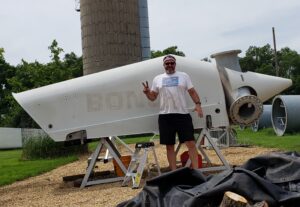Solar installation at Wildtype Native Plant Nursery, Michigan
February 22, 2023
Celebrating 20 Years of REAP Success Stories
The Rural Energy for America Program (REAP) is a bipartisan success story. Here’s how it can be even better.
Rural communities are critical to building America’s clean energy future. From small towns to farms and ranches, the Rural Energy for America Program helps people install solar panels and wind turbines, retrofit their buildings, and install new machinery to save energy. Since 2003, farmers and rural small business owners have used the Farm Bill’s popular Energy Title program to reduce energy waste and harvest the wind and sun alongside grain and livestock. Every year, demand for the program outstrips supply.

Rhonda & Brian Peterson in front of their new energy efficient refrigerators at Fiesta Foods rural grocery store, South Dakota
ELPC has been a champion of REAP since its inception, and we’re excited to see new federal funding to support this bipartisan program moving forward. REAP has a bright future, but there are several ways that it could be even stronger. Over the past year, ELPC talked to farmers and rural small business owners, to get a glimpse of who is using REAP and how. We also pulled together some recommendations for how this program could be even better. In our latest report, you can read all these stories and recommendations, but we’ll also be highlighting them in a series of blogs over the next few weeks.
A Bipartisan Success Story

Christopher Thomas with his refurbished wind turbine, Minnesota
Rural communities play an important role in our visionary roadmap for renewable energy in the Midwest. To translate that vision into law, ELPC led the charge to create the Farm Bill’s first-ever clean energy programs in 2002, which was first funded in 2003. The programs implemented that year included more than $400 million for clean energy development in rural communities. Over the years, these programs expanded into the Rural Energy for America Program (REAP), spurring over 22,000 energy efficiency and renewable energy development in all 50 states and every agricultural sector to this day.
ELPC has continued to provide a national leadership role in these efforts, documenting success stories over the years and working with a broad coalition of farmers and advocates to secure bipartisan support every year and additional funding over time. Because of the program’s well-documented successes, REAP was included in the Inflation Reduction Act (IRA) with nearly $2 billion over the next 10 years.
Looking Forward
ELPC will continue to strongly support REAP in the Farm Bill and advocate for changes we believe will strengthen the program and set it up for even greater success. Our main recommendations for updating REAP are:

Solar installation at Bowman & Landes Turkey Farm, Ohio
- Modernize – simplify the program & improve service. This includes explicitly making REAP a climate program, raising the cost-share cap to 50%, and improving technical assistance authority.
- Increase equity – increase outreach, including education to socially and historically disadvantaged, beginning, and veteran farmers and ranchers, and increase cost-share for these applicants to 75%.
- Create a stronger pipeline for projects – increase funding & availability for the Energy Audit and Renewable Energy Development Assistance (EA/REDA) program, which funds universities, states, and rural electric cooperatives to provide these services.
- Create a REAP rebate-style program – create a streamlined rebate option for pre-approved technologies with wide application, consisting of just a few pages of qualifying questions, to reach more people.
- Create Farm Energy Star – create a program for agricultural equipment, based on the EPA’s Energy Star program, to easily inform farmers about product energy usage based on independent studies.

Wildtype Native Plant Nursery’s shop dog Theo watches over the plants in their solar-powered greenhouse
The REAP program provides America a system to beneficially include agriculture in the transition to clean energy and reduce climate risks for all. The task before us is big but we have the capacity to rise to the climate challenge and overcome it to leave a safer world for generations to follow.
Interested in Applying for REAP Funds?
If you’re a farmer, rancher, or rural small business owner, you might be interested in using a REAP grants or loan guarantee to invest in energy efficiency or renewables. The best place to start is by contacting your State Rural Development Energy Coordinator, or exploring the REAP website here.

